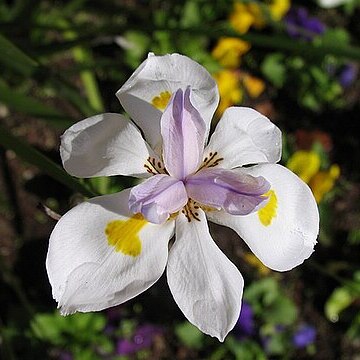Perennial herbs with thick, creeping rhizome. Stems erect; lower nodes leafy; upper with spathe-like bracts. Leaves basal and cauline, distichous, tough, equitant. Inflorescence a terminal panicle; bracts sheathing, subtending several flowers which open sequentially. Flowers ± actinomorphic, large. Perianth segments free, with an erect claw and an outspread limb. Filaments free or connate at base. Style branches large, flattened, petaloid, each with an transverse stigmatic flap and 2 petaloid crests. Capsule ± globose to ellipsoidal, usually ± erect. Seeds numerous, large, irregularly flattened.
Style dividing from near the base into 3 broad petaloid branches opposed to the outer tepals, each branch terminating in a pair of erect petaloid appendages (crests); stigmas transverse, abaxial, below the base of the crests.
Flowers several per rhipidium, pedicellate, borne serially, actinomorphic, Iris-like; pedicels pubescent above; tepals free, all broadly unguiculate, the limbs spreading, outer tepal claws pubescent.
Inflorescences composed of terminal rhipidia (umbellate flower clusters enclosed in paired opposed spathes); spathes sheathing, coriaceous, the outer spathe smaller than the inner.
Stem usually erect, bearing leaves at lower nodes, with sheathing leaves at the upper nodes; branching irregularly in the upper half, or forming a divaricately branched panicle.
Medium to large evergreen perennial herbs with thick creeping rhizomes, aerial parts persisting for several years.
Capsules erect or pendent, cartilaginous, irregularly grooved or smooth, tardily dehiscent or indehiscent.
Filaments usually free, occasionally united below, anthers linear, appressed to the style branches.
Leaves several, distichous, ensiform, coriaceous, without a midrib.
Seeds irregularly angled, fairly large.

